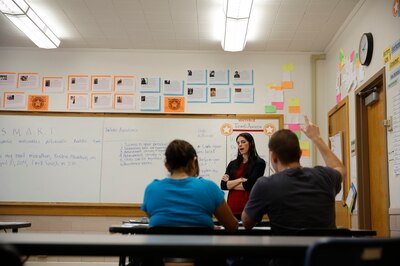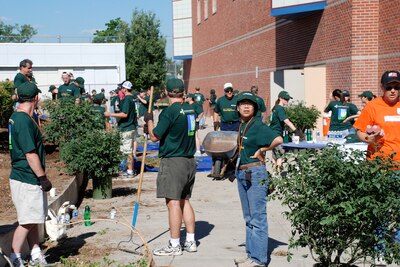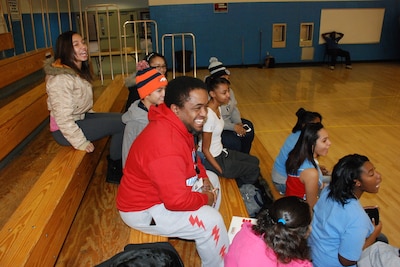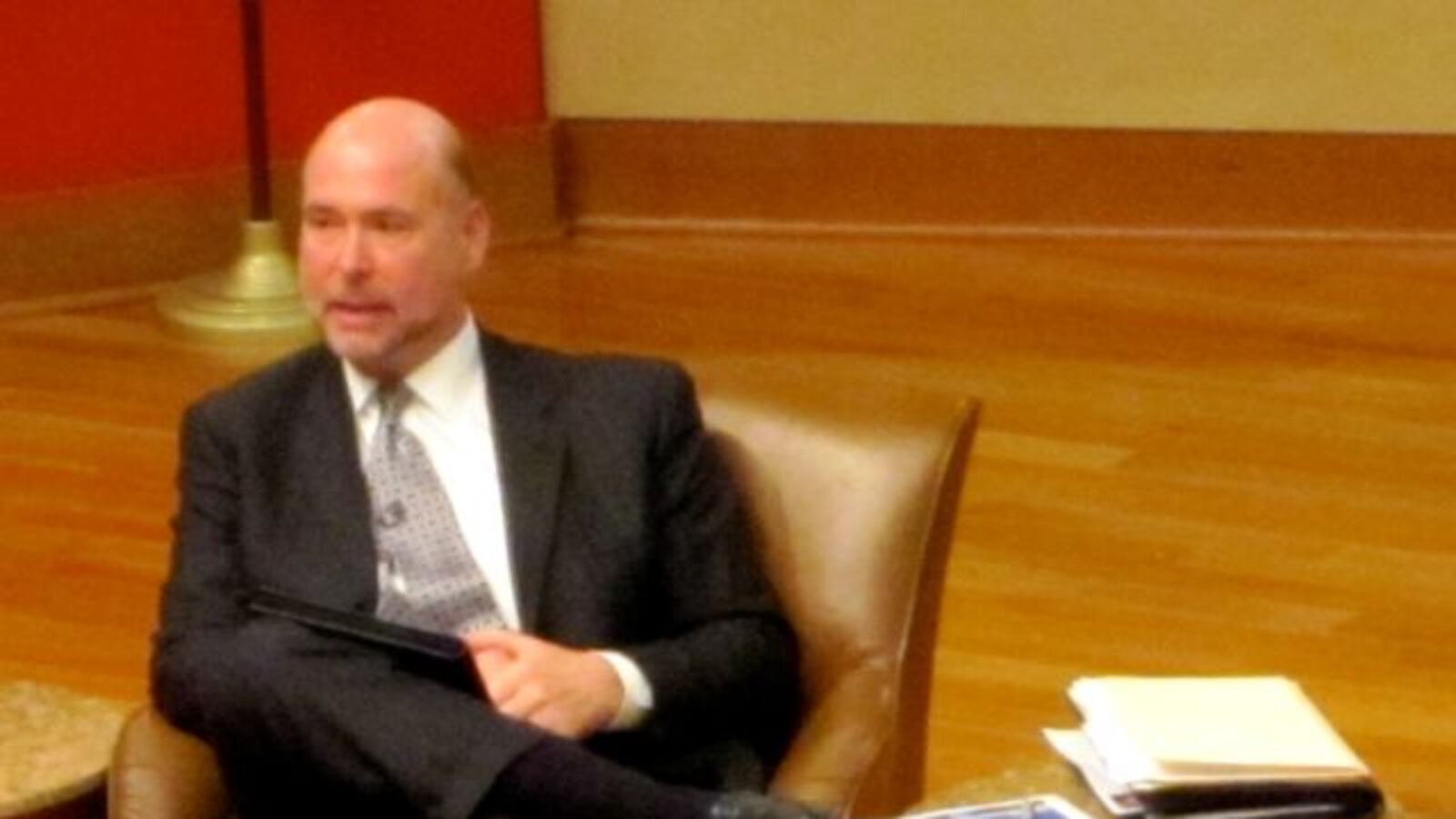Most school days, Horace Anderson opens up the kitchen in his home across the street from Manual High School to his daughter Nyesha and about 50 of her classmates for lunch.
Anderson is running a small business: Students buy plates of chicken fingers with fries and soda for $3.50. But more importantly, he’s also creating a safe space for students at the school.
Manual students close to the family call Anderson “dad.” Other students, often boys smoking in the alley, get a helping of life advice from the former gang member.
“I know how to communicate with them,” he said. “A lot of these kids get sidetracked. At this level, I did. But these kids, even the roughest I’ve dealt with are lost teddy bears on the inside.”
In many ways, Anderson, who runs a catering company, represents the best kind of guardian the Manual community has been known for: he keeps an eye on his student’s grades and visits with school officials and athletic coaches. His home is open to anyone in need of a conversation, a prayer or lunch. And he’s enthusiastic about the school’s current leaders and their commitment to broadening the horizons of their students.
Anderson also represents another aspect of Manual’s proud and tight-knit community, one that is more paradoxical. Like many parents of Manual students, he is aware of the school’s drastic drop on its Denver Public Schools rating. After a brief academic renaissance after 2007, when the school was closed for low performance and re-opened, Manual High School is once again the city’s lowest performing high school.
“It’s red,” Anderson said, referring to color-coding system that determines schools’ ratings, with blue the best and red the worst. “We got the report card.”
But Anderson, like many Manual parents interviewed for this story, did not understand the cause of the poor rating. “My daughter is on the honor roll,” Anderson boasted. And he was confident that his daughter was receiving the demanding academic work he wants for her. “She’d let me know if it wasn’t a challenge.”
Yet Anderson’s daughter — like every other African-American ninth and tenth grader at the school — failed to score proficient on last year’s state math exam.
Anderson’s discordant relationship with Manual — on one hand, a strong supporter, determined to see Manual’s children succeed; on the other hand, disconnected from the academic challenges that plague them — personifies the quandary that Manual school leaders face as they seek to work with the school’s community.
Over the years, as educators have worked to improve Manual, parents and the school’s broader local community have been a valuable resource, helping the school raise money, mentoring students and advocating for the school’s future. But with different understandings of the school’s strengths, educators and community members have often clashed over what Manual really needs.
“If you see some of the outcomes and listen to the complaints, it might not feel like a partnership [between the district and the community],” said Five Points community activist Jeff Fard, or Brother Jeff as he is most commonly known. “But more of a ‘we know what’s best approach.’”
Alienating the Manual community has never been the goal of the district, said former DPS board president Theresa Peña, who voted to close Manual.
The district, she said, has always kept the wishes of the community in mind. And that evaluating and deciding to close a school will initially come with community outcry.
“How do you have this broad inclusive process to have a community understand the problems at the school,” without having them feel like they’re horrible parents, she asked rhetorically in a recent interview. “I don’t think a community will ever feel good about a restart.”
Today, in our final installment on Manual High School’s struggles to improve, we explore the role that school’s community has played in its past and the role it might play in the future.
‘Totally segregated’
For much of its history since it opened in 1892, Manual was the centerpiece of its community, a source of pride for its tight-knit group of students, parents and alumni. For much of the the period between its opening and the 1970s, the school was the city’s premier high school for African-American students.

The neighborhoods around the school are populated by proud Manual alums, as well as their children and grandchildren, many of whom have heard stories of Manual’s glory days.
And after court-ordered desegregation began in the early 1970s, the school’s reputation only grew as the student body became more diverse. It soon became one of Denver’s flagship schools, known for its science and social studies programs and its championship-winning athletic teams.
Denver Mayor Michael Hancock and former Mayor Wellington Webb are among the school’s alumni. So are the late Corky Gonzales, one of the Mile High City’s most revered Latino activists, and the late Rachel B. Noel, the first African American woman to sit on Denver’s school board. So is Rob Stein, who eventually became the school’s principal.
But while the community’s pride and investment in the school were at their peak, it was unclear whether the school was succeeding in educating its neediest students — a shortcoming that foreshadowed struggles to come.
“Manual was really diverse,” said Buffy Naake, a Manual alum and former head of the school’s nonprofit, Friends of Manual, which fundraises and advocates for the school. “It was really integrated in some ways. But as we got older, white kids got tracked into [Advanced Placement] and accelerated classes. Our classrooms weren’t integrated. The sports teams, dances, electives, were. I don’t know [if] kids from the neighborhood were getting the same academic support as their white counterparts were getting.”
Then, in 1996, the city’s court-ordered busing program ended. Before the end of busing, the school had a population divided roughly even between white and black students that one former teacher, Mario Giardello, said felt “integrated and natural.” The last year of busing was his first year teaching at Manual. When he returned the following year, nearly all of the white and Asian students had disappeared, leaving behind a student body that was largely black and Latino, and impoverished.
Faced with the challenge of educating a student body that was much more disadvantaged, the school saw its storied academic prowess slip. By 2000, the school had the lowest test scores in the state. More and more students lived in poverty and other issues emerged in the school, including gang violence.
In 2000, intent on reversing the school’s slide, the school district used a $1 million grant from the Bill and Melinda Gates Foundation to split the school into three smaller schools, under the theory — at the time gaining in popularity — that smaller schools outperform their larger, comprehensive campus counterparts.
But the move did little to improve the school’s academic performance. In the midst of the small schools trial, during the 2003-04 school year, just 6 percent of students at Manual scored proficient on state exams. And the restructuring exacerbated other problems in the school.
“Manual was totally segregated,” Brother Jeff said. “Blacks were on one floor. Latinos, another. And the so-called ‘math and science group’ on another.”
Additionally, Brother Jeff felt that the transition to small schools marked a crucial breaking point in the community’s connection to the school.
“Manual has a long tradition of success, there is a strong sense of pride,” Brother Jeff said. “But when you have continuity broken — there are probably some students who don’t know the people who attended the school [before them] who went on to do great things.”
‘A minority and money thing’
Recognizing its failure, the school district organized a series of meetings in 2005 and 2006 with parents and community leaders in an attempt to gather input on how to revitalize the school. The district’s failure to follow through on its commitment to engage the school’s community created mistrust that reverberates to this day.
By time the district was prepared to make recommendations to the board, the community believed the complex would be consolidated and no new students would be enrolled while a new model was developed.
But after the district officials presented that plan to the city’s school board in February 2006, members instead voted to close Manual at the end of the year and send all of its students elsewhere. The decision sparked outcry in a community that felt misled and neglected by the district.
The day after the decision, students walked out and protested in front of DPS’s central administration building.
“They’re trying to push us out of the community,” Ashlee Taylor, then 18, told the Rocky Mountain News. “I think it’s a minority and money thing.”
A coalition of Denver’s black ministers held a community meeting to speak out against the closing.
James D. Peters Jr., pastor of New Hope Baptist Church, referred to supporters of the plan as “latter day members of the Ku Klux Klan.”
Despite the community outcry, then-superintendent Michael Bennet, district officials, and the school board members were resolute. The school’s poor state assessment results, coupled with a 20 percent four-year graduation rate, justified taking strong action to change the school, they said.
Peña said that the decision to shutter the school was not taken lightly, nor without consideration of the toll it would take on the school’s surrounding community.
“You don’t run for school board to close schools,” Peña said during a recent interview with Chalkbeat. “The loss in the community is huge. The school district agonized over every single closure.”
Students were supposed to be relocated for a year. Bennet and other administrators went door to door enrolling Manual students elsewhere and arranging transportation to students’ new schools. Reports conflict on how well the district managed the transition.
A year later, after much of the fever over the shutdown cooled, DPS earned a public relations coup when officials announced Rob Stein, the highly respected leader of private school Graland Country Day School, would be Manual’s leader.
‘Great needs’
“I’m here to listen,” Stein told a group of about 30 community members and parents at his first meeting after being appointed principal of Manual High School. While his immediate goal might have been to listen, he was also fighting an uphill battle to win over a community that felt betrayed and marginalized.

The crowd had more questions than comments or ideas themselves, according to notes from longtime observer of the school and Chalkbeat co-founder, Alan Gottlieb.
Will there be internships? How will you, as a white man, relate to the mostly minority community of Manual? Will there be sports teams? Open campus?
One African American mom asked, “It’s late and you’re just now on board. My son is signed up to attend Machebeuf next year. Why should I change my mind and send him to Manual?”
“Everything is on schedule,” Stein insisted, but added: “I totally agree. And I’m nervous about the pace myself. A lot of these ideas are not firmly fleshed out.”
Between April and August, Stein, Bennet and the Manual community rallied. While skeptics remained throughout Stein’s tenure, he was able to tap the school’s most prominent and influential alumni, like Naake, and parents to create momentum.
“Everyone was working so incredibly hard it was difficult to see anything other that what was right in front of us,” Naake said.
Before the school re-opened, Friends of Manual was in fundraising overdrive. Money was earmarked for a full time social worker, nurse and a scholarship foundation.
“What started to become so obvious was that the students [at Manual] had such great needs,” Naake said. “Emotional needs, family circumstances, that are just beyond comprehension.”
According to the Rocky Mountain News, more than 600 people, including then-City Council president Michael Hancock, showed up on Aug. 9 to spruce the campus up.
“As former head boy at Manual, I think I have the authority to anoint you all honorary Thunderbolts,” Hancock said.
“But I have to warn you,” he said. “Once a Thunderbolt, always a Thunderbolt. The Thunderbolts are about to rise again.”
‘I want a sense of pride’
For junior Elijah Huff, Manual is a family tradition — his parents and grandparents both attended the school, as did many other relatives. That’s why he choose to attend high school there. But that’s not why he’s determined to lead the boys basketball team to a state championship title.
“I want to change the culture of the school,” Huff said. “I want a sense of pride.”
For three years after the school re-opened, Hancock’s prediction that the Thunderbolts would rise again had seemed on the verge of coming true. Test scores were rebounding. The school was about to have its first senior class. Friends of Manual had raised $500,000. Community programs including the YMCA, YouthBiz and Denver Scholarship Foundation had permanent homes within the school.
But after the departure of Rob Stein, the school’s first turnaround principal, the school’s academic gains quickly eroded. And a series of missteps in the process to find a permanent replacement for Stein damaged the morale of community members who felt ignored.
And as far as many community members were concerned, the rebooted school had failed to resurrect one of the key elements to the school’s strong culture — its sports program.
No other high school sport is as important to the Manual community as boys basketball. Since 1930 no other school has won more state championships.

But now, both goals — winning a state championship and recapturing the Thunderbolt spirit of decades gone by — are easier said than done.
Since the school re-opened, there hasn’t been a serious effort to build a team, a concern of Anderson and other parents. Sports, en masse, never played a significant role in Stein’s model. But they go a long way in building school community, Anderson said.
Assistant principal Vernon Jones contends, Manual “can ball with anybody.” But so far this season the 3A division boys have won one game in eight.
The Thunderdome, Manual’s home basketball court, is arguably one of the best athletic facilities in Denver Public Schools.
But on an early Saturday in January, the home bleachers were devoid of proud Manual parents, alumni and students. In their place was a spillover from the visitor’s side. Comfortably spread out were parents from the more affluent Cherry Creek High School.
“Our parents are probably working,” Jones said. “They’re making sure food is on the table, their heating bill is paid.”
Despite the poor turnout at the basketball games, there are signs the school is recovering some of the school spirit and winning back parents and community support, Jones said.
The Hispanic Chamber of Commerce recently held a board meeting at the campus. And since the school has reopened, the Denver Scholarship Foundation has awarded $147,325 in funds for college to 56 students from Manual.
A half dozen parents interviewed by Chalkbeat at a December girls basketball game spoke highly of the school’s current leaders, Dale and Jones.
We’re on a first name basis, one mother said.
They know how to get ahold of me if something is wrong, said another.
The experiential learning model, in which the school takes students on week long field trips to Little Rock, Ark. and Memphis, Tenn., is working, said another.
But they were also unaware of the school’s and their own student’s dismal postings on state assessments last year.
“I don’t see how,” said Nina Adams whose has a freshman and junior enrolled at Manual. “That’s so different, my daughters’ grades are fine.”
A promise unfulfilled
School administrators and community leaders are aware of the problems inherent in a school that has built a warm, supportive community but that still fails to produce graduates who are ready for college. But they have yet to figure out how to implement a solution that will stick.
They’re also acutely aware of a string of promises that has been made to the community around Manual High School that have, one after the other, been left unfulfilled:
Desegregation in the 1970s was supposed to lift up the community, but in reality, neighborhood kids were often left behind.
A small schools model in 2000 assured the community their children wouldn’t get lost, but in reality, the school’s culture was so toxic, performance stagnated and many students dropped out.
The rebirth of Manual was touted as the fresh start the community needed, but in reality, the foundation laid was in haste and had no chance of surviving bureaucratic processes.
Today’s promise is that Manual graduates will be college and career ready — and socially aware. Manual graduates will be able to transform their community.
“They’re trying to turn the whole thinking around,” Brother Jeff, the community activist, said. “From deficit thinking to revolutionary thinking.”
But to do that, the school needs to significantly boost its performance or risk adding to the list of disappointments that the community has shouldered.
“The pressure is on us,” Jones said. “We need to perform. If we fail, we fail the community.”


